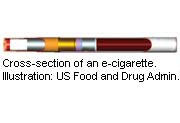- Skip Storing This Everyday Product in the Fridge Door
- Green Tea + B3 Pairing May Boost Brain Health
- Navigating Your Midlife Crisis: Embracing New Possibilities
- City Raccoons Showing Signs of Domestication
- Mapping the Exposome: Science Broadens Focus to Environmental Disease Triggers
- One Week Less on Social Media Linked to Better Mental Health
- Your Brain Changes in Stages as You Age, Study Finds
- Some Suicide Victims Show No Typical Warning Signs, Study Finds
- ByHeart Formula Faces Lawsuits After Babies Sickened With Botulism
- Switch to Vegan Diet Could Cut Your Greenhouse Gas Emissions in Half
E-Cigarettes: Separating Fiction From Fact


It’s the new year, a time when a smokers’ thoughts often turn to quitting.
Some people may use that promise of a fresh start to trade their tobacco cigarettes for an electronic cigarette, a device that attempts to mimic the look and feel of a cigarette and often contains nicotine.
Here’s what you need to know about e-cigarettes:
What is an e-cigarette?
The U.S. Food and Drug Administration (FDA) describes an e-cigarette as a battery-operated device that turns nicotine, flavorings and other chemicals into a vapor that can be inhaled. The ones that contain nicotine offer varying concentrations of nicotine. Most are designed to look like a tobacco cigarette, but some look like everyday objects, such as pens or USB drives, according to the FDA.
How does an e-cigarette work?
“Nicotine or flavorings are dissolved into propylene glycol usually, though it’s hard to know for sure because they’re not regulated,” explained smoking cessation expert Dr. Gordon Strauss, founder of QuitGroups and a psychiatrist at Lenox Hill Hospital in New York City. “Then, when heated, you can inhale the vapor.”
The process of using an e-cigarette is called “vaping” rather than smoking, according to Hilary Tindle, an assistant professor of medicine and director of the tobacco treatment service at the University of Pittsburgh Medical Center. She said that people who use electronic cigarettes are called “vapers” rather than smokers.
Although many e-cigarettes are designed to look like regular cigarettes, both Tindle and Strauss said they don’t exactly replicate the smoking experience, particularly when it comes to the nicotine delivery. Most of the nicotine in e-cigarettes gets into the bloodstream through the soft tissue of your cheeks (buccal mucosa) instead of through your lungs, like it does with a tobacco cigarette.
“Nicotine from a regular cigarette gets to the brain much quicker, which may make them more addictive and satisfying,” Strauss said.
Where can e-cigarettes be used?
“People want to use e-cigarettes anywhere they can’t smoke,” Strauss said. “I sat next to someone on a plane who was using an e-cigarette. He was using it to get nicotine during the flight.” But he noted that just where it’s OK to use an e-cigarette — indoors, for instance? — remains unclear.
Wherever they’re used, though, he said it’s unlikely that anyone would get more than a miniscule amount of nicotine secondhand from an e-cigarette.
Can an e-cigarette help people quit smoking?
That, too, seems to be an unanswered question. Tindle said that “it’s too early to tell definitively that e-cigarettes can help people quit.”
A study published in The Lancet in September was the first moderately sized, randomized and controlled trial of the use of e-cigarettes to quit smoking, she said. It compared nicotine-containing e-cigarettes to nicotine patches and to e-cigarettes that simply contained flavorings. The researchers found essentially no differences in the quit rates for the products after six months of use.
“E-cigarettes didn’t do worse than the patch, and there were no differences in the adverse events,” she said. “I would be happy if it turned out to be a safe and effective alternative for quitting, but we need a few more large trials for safety and efficacy.”
Strauss noted that “although we can’t say with certainty that e-cigarettes are an effective way to quit, people are using them” for that purpose. “Some people have told me that e-cigarettes are like a godsend,” he said.
Former smoker Elizabeth Phillips would agree. She’s been smoke-free since July 2012 with the help of e-cigarettes, which she used for about eight months after giving up tobacco cigarettes.
“E-cigarettes allowed me to gradually quit smoking without completely removing myself from the physical actions and social experience associated with smoking,” Phillips said. “I consider my e-cigarette experience as a baby step that changed my life.”
Are e-cigarettes approved or regulated by the government?
E-cigarettes are not currently regulated in a specific way by the FDA. The agency would like to change this, however, and last April filed a request for the authority to regulate e-cigarettes as a tobacco product.
The attorneys general of 40 states agree that electronic cigarettes should be regulated and sent a letter to the FDA in September requesting oversight of the products. They contend that e-cigarettes are being marketed to children; some brands have fruit and candy flavors or are advertising with cartoon characters. And, they note that the health effects of e-cigarettes have not been well-studied, especially in children.
Are e-cigarettes dangerous?
“It’s not the nicotine in cigarettes that kills you, and the nicotine in e-cigarettes probably won’t really hurt you either, but again, it hasn’t been studied,” Strauss said. “Is smoking something out of a metal and plastic container safer than a cigarette? Cigarettes are already so bad for you it’s hard to imagine anything worse. But, it’s a risk/benefit analysis. For a parent trying to quit, we know that secondhand smoke is a huge risk to kids, so if an electronic cigarette keeps you from smoking, maybe you’d be helping kids with asthma or saving babies.”
But on the flip side, he said, in former smokers, using an e-cigarette could trigger the urge to smoke again.
The other big concern is children using e-cigarettes.
“More and more middle and high school kids are using e-cigarettes,” Tindle said. “Some are smoking conventional cigarettes, too. The latest data from the CDC found the rate of teens reporting ever having used an e-cigarette doubled in just a year. We could be creating new nicotine addicts. We don’t know what the addictive properties of e-cigarettes are,” she added.
“It’s shocking that they’ve been allowed to sell to minors,” Tindle said.
More information
The U.S. Food and Drug Administration has more about electronic cigarettes.
This HealthDay story describes options to help you quit smoking.
Source: HealthDay
Copyright © 2025 HealthDay. All rights reserved.










